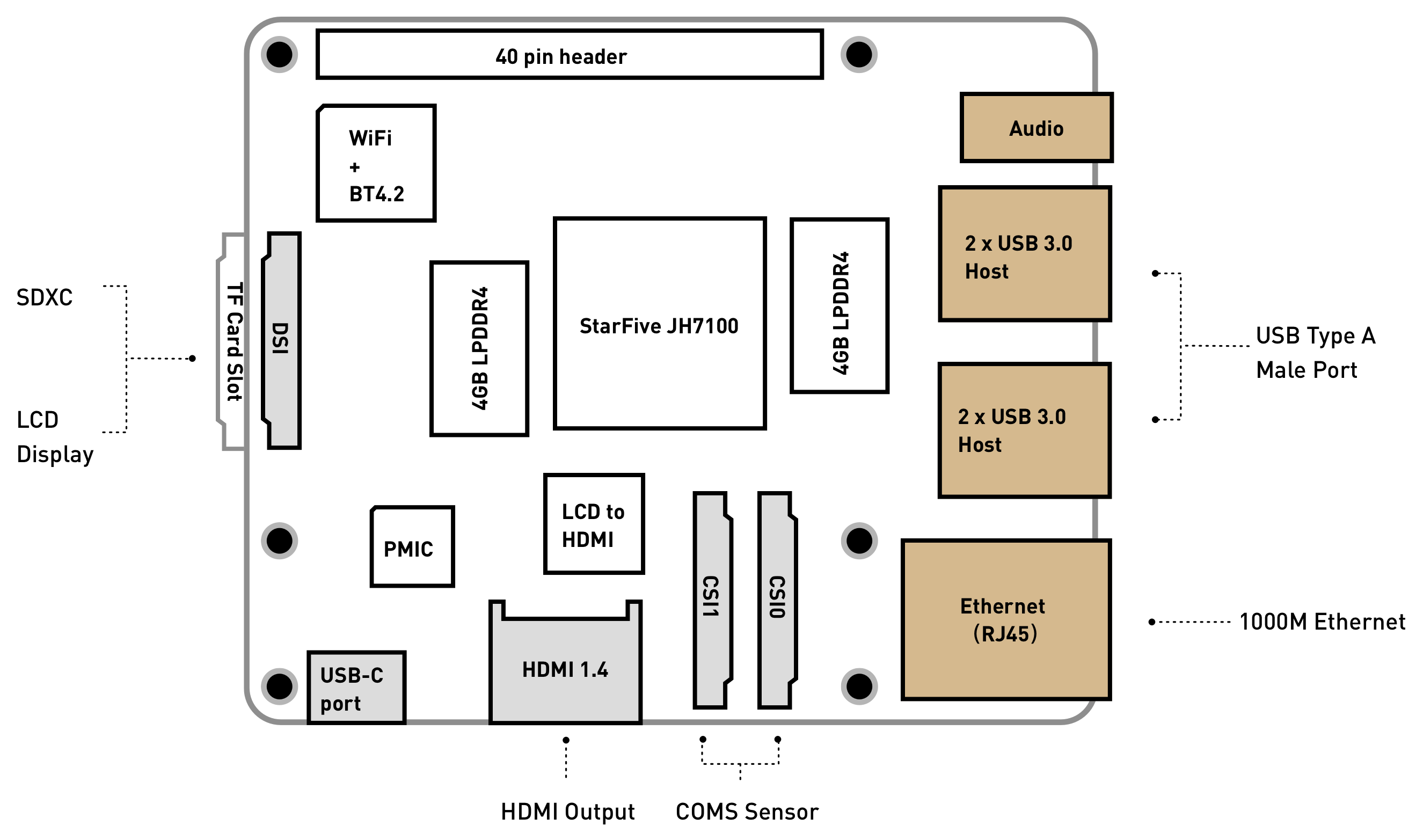
Until recently, motherboards based on the RISC-V processor, such as the Kendryte K210 , could not be used for highly resource-intensive tasks. end performance was very low. In particular, the XuanTie C906 single board computer based on Allwinner RISC-V could only be used for niche small tasks, for example, as a camera due to the lack of a hardware graphics accelerator and the presence of only 256 MB of RAM. Single board computers such as the SiFive HiFive Unmatched or PolarBerry can be used , but the final system costs hundreds or even more than a thousand dollars, which is quite expensive.
Thus, there is a clear need for an inexpensive Linux single board computer built on a high performance RISC-V processor. And in great news, the BeagleBoard.org Foundation , Seeed Studio, and Chinese factory chip manufacturer Starfive have teamed up to design and manufacture a BeagleV (Beagle Five) single board computer based on a StarFive JH7100 dual-core processor (SiFive U74 RISC-V core) with a digital signal processor (DSP) ) for computer vision, the NVDLA machine learning accelerator (Deep learning) and a neural network for artificial intelligence (AI).
BeagleV specifications:
 : SoC — StarFive JH7100 Vision SoC :
: SoC — StarFive JH7100 Vision SoC :
- RISC-V U74 2MB L2 cache @ 1.5 GHz
- Vision DSP Tensilica-VP6
- NVDLA Engine 1 core (configuration 2048 MACs @ 800MHz – 3.5 TOPS)
- (1024MACs @ 500MHz – 1 TOPS)
- VPU – H.264/H.265 decoder up to 4Kp60, dual-stream decoding up to 2Kp30
- JPEG encoder/decoder
- (DSP)
 : 4GB 8GB LPDDR4
: 4GB 8GB LPDDR4 : MicroSD
: MicroSD :
:
- 1x HDMI 1080p30
- 1x MIPI DSI 4Kp30
- MIPI-CSI TX (AI)
 : (ISP) 4K @ 30FPS, 2 x MIPI-CSI Rx
: (ISP) 4K @ 30FPS, 2 x MIPI-CSI Rx : (3.5 mm TRRS jack)
: (3.5 mm TRRS jack) : 1x Gigabit Ethernet, 2.4 GHz 802.11b/g/n WiFi 4, Bluetooth 4.2
: 1x Gigabit Ethernet, 2.4 GHz 802.11b/g/n WiFi 4, Bluetooth 4.2 USB: 4 USB 3.0
USB: 4 USB 3.0 Expansions Header: 40- Raspberry Pi 3, GPIO 28 x GPIO, I2C, I2S, SPI, UART
Expansions Header: 40- Raspberry Pi 3, GPIO 28 x GPIO, I2C, I2S, SPI, UART : TRNG OTP
: TRNG OTP :
:  : 5V/3A USB Type-C
: 5V/3A USB Type-C : 90×70 () .
: 90×70 () .

Based on the SiFive U74 core , the performance should be equivalent to the Cortex-A55 core. The Cortex-A55 is the receiver of the Cortex-A53 on which the Allwinner A64 processor is built . According to ARM, the Cortex-A55 core is 18% more powerful and 15% more energy efficient. The Banana Pi BPI-M64 board contains 4 Cortex-A53 cores at 1.2 GHz, while the BeagleV will contain two RISC-V U74 cores at 1.5 GHz, which indicates almost identical performance.
Therefore, the performance of the BeagleV single board computer will not be as high as compared to the boards based on the Arm processor, but due to the presence of the neural network and digital vision accelerator module, the BeagleV will be competitive compared to other boards with artificial intelligence, such as the Coral Dev Board mini .
The first shipment of boards scheduled for March will be GPU-free, but the next one due in September will be GPU-powered by Imagination Technologies.
Support for BeagleV will be upstream of mainline Linux, and the OS image will be built on the Debian version. This will support Fedora and FreeRTOS. RISC-V single board computers are open-source hardware like other boards from BeagleBoard.org, which means that hardware design files, firmware and software will be publicly available.
The final price of the BeagleV will be $ 119 with 4GB of RAM and $ 149 with 8GB of RAM, but the first batch will only ship with 8GB of RAM. Enthusiasts and geeks can fill out a fee application on the site. You can also pre-order the board in Seeed Studio. More information can be found on the product page...
Links:
- $ 119 + BeagleV powerful, open-hardware RISC-V Linux SBC targets AI applications - cnx-software.com
- SiFive Introduces 7 Series RISC-V Cores with E7, S7 and U7 series - cnx-software.com
- BeagleV Application Form